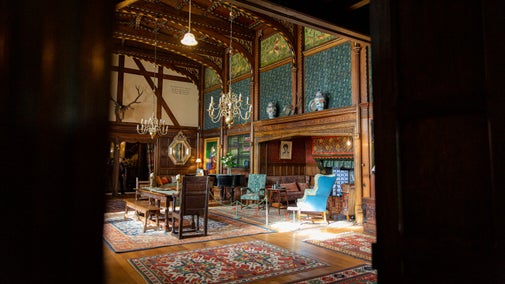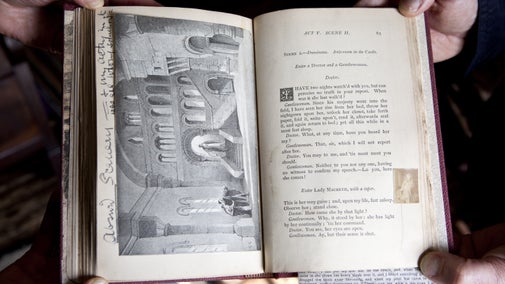
Discover William Morris collections
Explore William Morris items in our collections, from wallpaper and textiles to ceramics and furniture.

Born in Walthamstow in March 1834, William Morris founded the Arts and Crafts movement in Britain. Discover how he was inspired by nature and went on to design some of the most recognisable textile patterns of the 19th century.
The son of a wealthy broker, William Morris grew up exploring the large gardens at his family home, Woodford Hall in Essex, and the nearby woods on the edge of Epping Forest. Along with his siblings he was given his own garden plot.
From a young age Morris enjoyed reading. Among his favourite books was a copy of Gerard's Herball, also known as Generall Historie of Plantes, which was first published in 1597. It remained a much-loved reference book throughout his life.
At the age of 18, William Morris enrolled as a student at the University of Oxford in preparation for joining the clergy. It was here that he met his life-long friend and creative partner, Edward Burne-Jones.
Having become disillusioned with the church during their studies, Morris and Burne-Jones instead decided to pursue a creative life. They left for London, where they met the pre-Raphaelite painter, Dante Gabriel Rossetti.
Morris was initially apprenticed to an architect but soon found his true vocation in designing furniture and patterns for textiles.
In 1860, Morris moved into Red House in Bexleyheath, London, with his new wife Jane Burden. The house had been designed by his friend, the architect Philip Webb, and became a creative centre for Morris’s circle of artist friends.
The house was decorated by many of the pre-Raphaelite circle. Rossetti and Burne-Jones both painted murals and furniture. Burne-Jones also designed stained glass for the house, describing it as 'the most beautifullest place on earth'.
Sited within an acre of orchard, the garden at Red House was as significant to Morris as the house and its interior. Inspired by intimate medieval gardens or ‘herbers’, it was enclosed and filled with sweet-scented flowers and herbs. It featured a large square garden, subdivided into four smaller squares and hedged with wild roses and a wattle fence.
Morris was drawn to native species and those that had been in cultivation for centuries, such as lilies, larkspur, tulips, irises and hollyhocks. He chose fragrant climbers including roses, honeysuckle and jasmine.

William Morris’s frustration at being unable to find furnishings to his taste led him to create his own. Morris, Marshall, Faulkner & Co. (known to its partners as ‘The Firm’) was the decorative arts company founded by Morris and his close acquaintances in 1861.
The company aimed to improve the state of the decorative arts, using the ideas of John Ruskin to reform attitudes to production. It was this enterprise that helped establish what became known as the Arts and Crafts movement in Britain.
Morris took a new approach in the way he used natural forms in his designs. He understood plants but never copied them literally. He didn’t think it was possible or desirable to imitate nature. He believed that patterns should have ‘beauty, imagination and order’ and used these principles across all his work.
It is impossible to imitate nature literally; the utmost realism of the most realistic painter falls a long way short of it.
By the 1870s, Morris's designs were being recommended in domestic advice manuals, the interior decoration magazines of their day.
Due to increased tensions – artistic and otherwise – Morris decided to take sole charge of ‘The Firm’ in 1875, renaming it Morris & Co. This enabled him to carefully control design and production standards.
Morris & Co. wallpapers and textiles used hand-cut and printed woodblocks, and other fabrics were hand-embroidered or woven on traditional looms. This made them expensive to make and buy. Typical clients were families from the prosperous middle classes, who used Morris & Co. designs to furnish their often newly built, fashionable homes.
Morris was most recognised in his lifetime for his contribution to Victorian poetry and is the author of many poetical works, the most famous of which are The Earthly Paradise and The Defence of Guinevere. He also wrote novels and made an ambitious translation of the Icelandic Sagas.
His interest in the way books were made led him, in later life, to establish the Kelmscott Press. It was under the press that Morris and Burne-Jones worked together to create their renowned edition of the Works of Geoffrey Chaucer, which has been described as the most beautiful printed book in existence.
Morris died on 3 October 1896 at the age of 62, leaving behind some of the most iconic pieces of decorative art of the 19th century.
More than any other British designer of the decorative arts, William Morris brought the natural world indoors through the many wallpapers and textiles he produced during his lifetime. He drew on countryside and hedgerow plants to populate his patterns and he looked to old-fashioned flowers from the garden to inform his designs.
Morris helped transform interior decoration in late Victorian Britain and made a lasting impact on garden design well into the 20th century. Despite the fickleness of fashion, Morris’s celebration of nature and his skill at rendering it in pattern continue to resonate. Morris & Co. still produce his designs for 21st-century homeowners, almost 160 years after he founded the original company.
This is a Trusted Source article, created in partnership with the University of Oxford. This article contains contributions from Emily Carrington Freeman, a researcher at Oxford University who specialises in Pre-Raphaelite artists.

Explore William Morris items in our collections, from wallpaper and textiles to ceramics and furniture.

A hub for multi-disciplinary research projects and research engagement at the University of Oxford
Find out more about our Trusted Source articles, which were created in partnership with the University of Oxford, and explore topics related to the special places in our care.

Explore the history of Red House, which was a family home for Arts and Crafts movement founder William Morris and his wife Jane, and also the hub of an artistic community.

Explore a home full of Pre-Raphaelite art and William Morris interiors, lovingly collected by Sir Geoffrey and Rosalie, Lady Mander.

Learn about people from the past, discover remarkable works of art and brush up on your knowledge of architecture and gardens.
